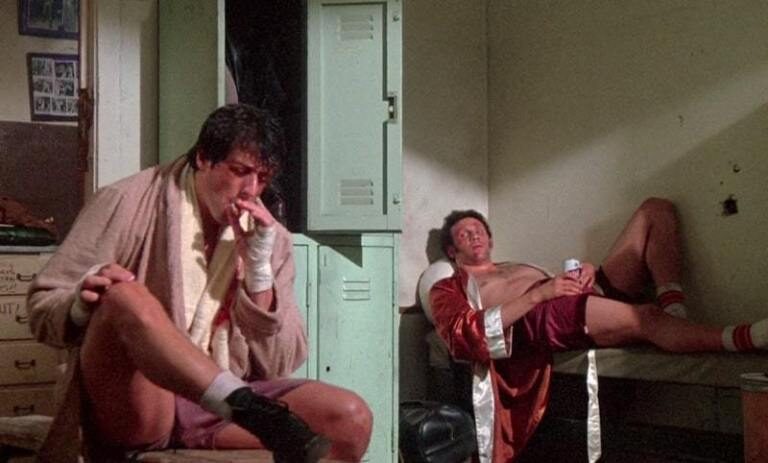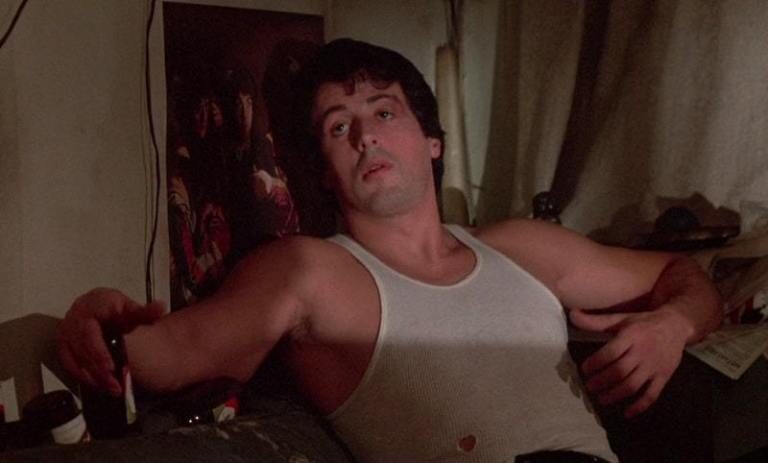From Bum to Italian Stallion: Sylvester Stallone as Rocky | http://clothesonfilm.net
In the very opening scene of Rocky (1976, costume designer Robert Cambel), we see the title character in the ring, bare chested, hands encased in boxing gloves, the picture of sporting violence and masculinity. But this is no more than a surface assumption. Not two minutes later, we see Rocky Balboa (Sylvester Stallone) shrug on his faded brown towelling dressing gown, with “The Italian Stallion” embroidered on the back, and things start to shift. This is not a macho film concerned with the fight alone, but an exploration of masculinity in all its guises – the assumptions, the pretence and the reality. Clothes play an important part in this, both as items we believe the characters select for themselves on a daily basis, and as literal costumes chosen for performance in the ‘show’ of the boxing ring.
The aforementioned dressing gown is perfect in that it’s reminiscent of the flashy boxing stereotype, yet there is a vast disparity. Rocky has seen those flashy silk dressing gowns, with their bright colours and their boastful nicknames emblazoned on the back. His fellow boxer who lounges on a bench beside him is decked out in a bright silky gown himself. Rocky wants to be part of this world, but he gets it wrong – partly through his lack of means, partly through his misunderstanding and partly through his personal differences to those around him. The murky, faded colour is washed out, a bit like the man himself at this point. Rocky asks when he’s next fighting, keen to be improving, respected within his sport, but is met with a non-committal mutter “Maybe in a few weeks”. He wants to be so much more than he is. Just as his dressing gown is a poor imitation, he is a fraction of what he wants to become.
We then see him leave the boxing club and walk home through the dark streets wearing a grey faded sweatshirt and dark jeans with his black leather jacket and black wool fedora with a feather in the brim. His fingerless gloves recall the bandages he wraps around his hands to fight. We see no one else dressed quite like him. He wants to be an individual, to stand out from the crowd, and yet he desperately wants to fit in. He greets crowds of people in the streets – everyone seems to know and like him. This continues throughout the earlier part of the film demonstrating his need to belong. Rocky’s clothes are a mixture of stylish and casual, considered yet throwaway. There is pretence of carelessness with an awareness of image.
The contrast between Rocky and those around him is frequently highlighted. At the beginning of the film, Rocky is working as a debt collector for a seedy businessman; the contrast between him and his boss is strongly highlighted through their clothes. His boss wears a striped white and pink shirt, a grey suit and a knee length wool overcoat. In comparison Rocky almost seems to be playing dress up. He is evidently refusing to conform. Though he works for this man, he doesn’t respect him or aspire to be like him. It is a way of earning money that suits him, but it’s not a way of life. He also stands apart at the boxing club, often walking through the half-dressed fighting bodies in his leather jacket and hat, at a distance even from those he aspires to join. His leather jacket, with all its connotations of being anti-establishment, tough, masculine and rebellious, deliberately isolates Rocky from those around him.
The leather jacket could be said to be something of a street uniform – not that it is worn by everyone on the street, but that its meaning is universally recognised. The leather jacket has come to symbolise rebellion and frustrated youth culture. While Rocky is not exactly a part of this so-called youth culture, he is past 30 for a start, he still retains a lot of those ideals – of hope and of forging your own path. He is an interesting character, full of conflicts and contradictions. This is followed through in his costuming, in the texture and colour of his clothes. For example, the darkness and strength of Rocky’s leather jacket against the soft faded grey of his jersey sweatshirt.
When Rocky starts training he wears grey again, in several layers to bulk him up. He looks far from an elite fighting machine, the worn colouring speaking of his ineffectual career so far. The shade is patchy and faded. Despite Rocky’s best efforts, he isn’t shown as a true contender. The jogging outfit also has his “Italian Stallion” moniker on the back. Rocky clings to this distinction, aware of the image he is trying to create, yet not quite succeeding.
When Rocky goes out on his first date with Adrian (Talia Shire) he wears a black mock turtle-neck under a grey V-neck cable knit, completed with leather jacket and black hat. The detail that stands apart from this outfit is, again, the multiple layers. They act as protection, as a barrier against the world. By physically separating a person from their surroundings, layers have the effect of mentally distancing someone as well. Clothes are armour, to protect and project what we wish the world to see.
Adrian is similarly dressed for the date – an unexpected and reluctant surprise while at work – initially wearing an apron over her clothes. However Adrian soon emerges clutching the apron in her hand, yet even more covered up with a long double breasted coat and teal wool hat with a rolled double brim. The coat is fastened to the top, her cardigan underneath fully buttoned to the neck. She has on gloves and glasses and clutches a handbag almost like a shield. This is layer upon layer of protection. When Rocky persuades her to come back to his apartment, he strips down to his off-white vest, remarking on how hot it is. He is more comfortable at home, especially as the evening seems to be going well. There is even a hole in the vest – the focus is now on the flesh rather than the covering. Rocky’s masculinity in this scene is synonymous with his physique, while also reminiscent of boxing attire. Boxing is the thing Rocky cares about most at this juncture, something he does for love and pride. By evoking this connotation Rocky displays what he feels to be the best of himself.
Adrian remarks – “I don’t belong here” – and the contrast between her, bundled up in that coat and hat, and Rocky, suddenly pared down to his vest, is obvious. When they kiss, he first removes her glasses and hat, destroying the physical and emotional barriers between them. After this point, Adrian’s look develops throughout the film, becoming more colourful and more fitted as she gains confidence in her relationship with Rocky. Their outfits continue to mirror each other, for example when they watch his televised press conference with Apollo Creed, the oranges and browns of his jumper pick up the rust tone of her cardigan and her floral cream shirt. Later, before the big fight, her white shirt and red beanie match the red of Rocky’s gown and the white towel around his neck. Later when Adrian greets Rocky on the steps of his apartment, she is dressed in a fitted orange double breasted coat with fur collar and cuffs and a full skirt, finished with a fluffy white beret. This outfit shows Adrian’s growing confidence with the bold colour and fitted shape, but retains her personal style via the hat and double breasted fastening. Rocky exclaims on seeing her, “You gonna be walking down the street breaking hearts the way you’re looking.” She tugs on her coat, seeking approval, but we can tell that she is gaining self-assurance (see our earlier deconstruction of Adrian’s most important looks HERE).
In absolute contrast to Rocky, when we first see Apollo Creed (Carl Weathers) he is sharply turned out in a 3 piece suit with a flamboyant floral tie. This is a statement look for Creed until his big boxing showdown with Rock – he is powerful, successful and very much aware of his position. Apollo doesn’t consider Rocky to be a real contender, and instead sees their bout as a “show”. This is even more apparent when he arrives to the fight on a float, wearing a wig, hat and full-on sparkling American flag tailcoat and cape over his striped boxing shorts. Apollo is surrounded by others in costume and the whole event seems more like a pageant rather than a fight. Rocky remarks, perplexed, “He looks like a big flag”.
Rocky is now kitted out in a red and yellow silk edged robe, with an advert for ‘Shamrock Meats Inc.’ stitched above his “Italian Stallion” nickname. His coach remarks, “I trained you to be a fighter not a billboard”. But Rocky wanted a new robe and doesn’t mind doing his friend at Shamrock Meats a favour to get one. His last parting words to Adrian are “You don’t think this robe is too baggy?” Rocky is completely aware of the importance of image. He demonstrates this even more blatantly at the arena the night before his fight, remarking, “The poster’s wrong. I’m wearing white shorts with a red stripe” (the image shows him in red shorts with a white stripe instead). The promoter replies, “That doesn’t really matter does it? I’m sure you’re going to give us a great show”. Both these instances were reportedly accidental – a mistake in the painting of the poster, a robe slightly too big – but Rocky’s awareness of his appearance allows these mistakes to add to rather than detract from the complexity of the character. Rocky understands the politics behind the game and the fact that he is not taken seriously; he wants to maintain his integrity. As he says to Adrian, “All I wanna do is go the distance. Then I’d know for the first time in my life you see? That I weren’t just another bum from the neighbourhood.” This is the key to Rocky. This final fighting outfit is a far cry from his appearance at the beginning of the film. No amount of blood on his silky white shorts can change the huge significance of Rocky’s sartorial transformation.
Rocky is a film which deals with a complex protagonist who is aware of the power of image and aspiration, yet whose sartorial choices tell us more than he knows. His dress sense demonstrates a longing to be individual, yet conversely to fit in; to be part of an elite set, yet to stay true to his ideals. He is a man of contradictions through the varying guises of masculinity: toughness, physical strength, sensitivity, doubt and self-awareness – all of which are communicated through excellent costume choices.
By Bonnie Radcliffe
Bonnie Radcliffe has worked in a variety of roles in costume for film, television and theatre; loves clothes and is fascinated by people, especially the way clothes can create a living, breathing character.
NOTE: Images have been screencapped from Blu-ray edition and cropped to better highlight costumes.
© 2014, Lord Christopher Laverty.











